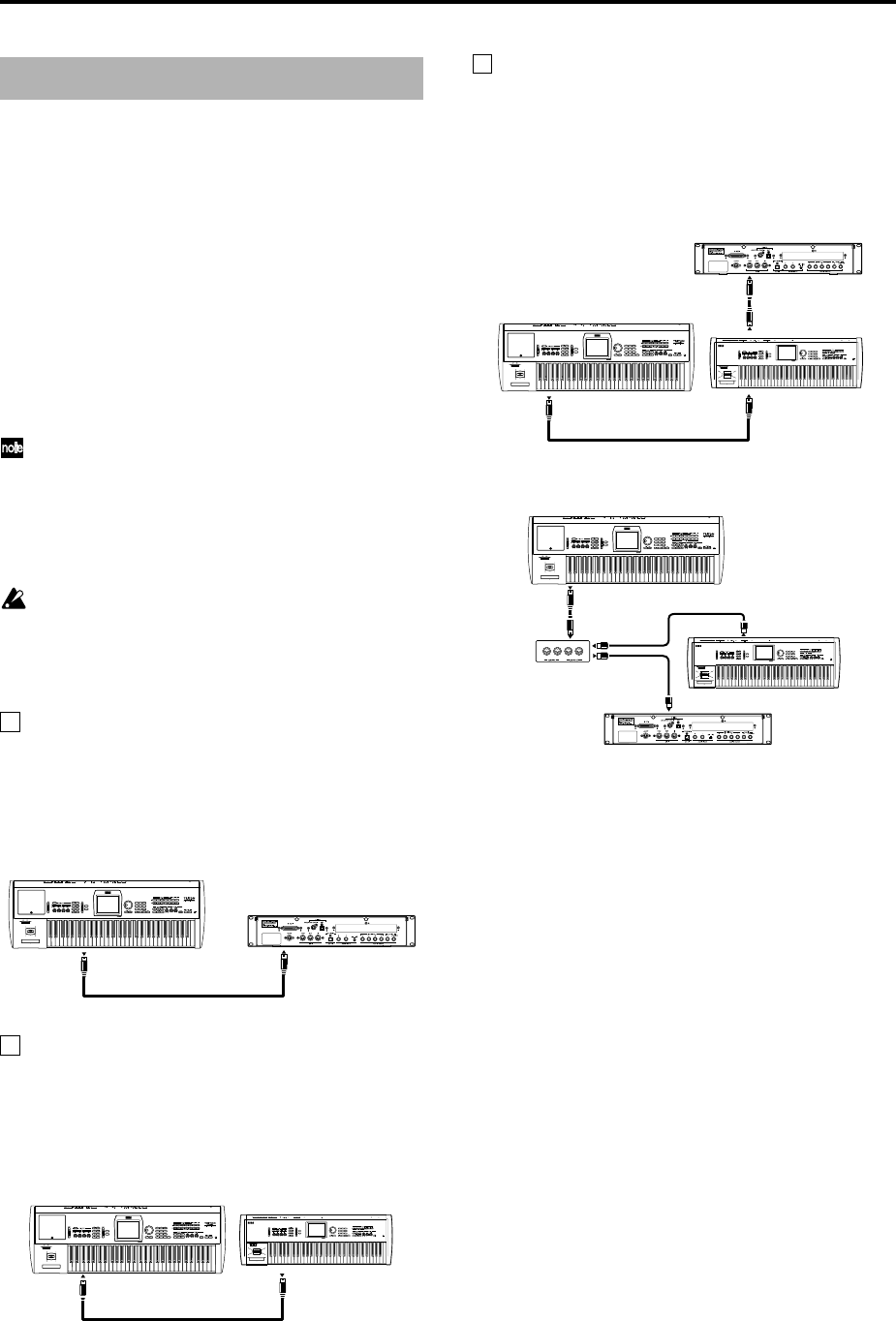
258
■ About MIDI
MIDI stands for Musical Instrument Digital Interface, and is
a world-wide standard for exchanging various types of
musical data between electronic musical instruments and
computers. When MIDI cables are used to connect two or
more MIDI devices, performance data can be exchanged
between the devices, even if they were made by different
manufacturers.
■ Connecting MIDI devices/computers
(MIDI connectors)
If the EXB-mLAN option is installed, the mLAN con-
nector of the TRITON STUDIO can be connected to an
external mLAN-compatible MIDI device or FireWire-
capable Macintosh to receive and transmit MIDI. For
details on connections, refer to the “EXB-mLAN
owner’s manual” included with the EXB-mLAN
option.
When exchanging MIDI dumps with a computer via
the EXB-mLAN option, it is not currently possible for
an OMS-compatible application to store or play back
TRITON STUDIO dump data (the same applies to the
TRITON-Rack).
Controlling an external MIDI tone genera-
tor from the TRITON STUDIO
When you wish to use the TRITON STUDIO’s keyboard,
controllers, and sequencer etc. to play an external MIDI tone
generator, use a MIDI cable to connect the TRITON STU-
DIO’s MIDI OUT connector to the MIDI IN connector of the
external MIDI tone generator.
Controlling the TRITON STUDIO’s tone gen-
erator from an external MIDI device
When you wish to play or control the TRITON STUDIO’s
tone generator from an external MIDI keyboard or
sequencer etc., use a MIDI cable to connect the MIDI OUT
connector of the external MIDI device to the MIDI IN con-
nector of the TRITON STUDIO.
Controlling two or more external MIDI tone
generators from the TRITON STUDIO
You can use the MIDI THRU jack to simultaneously control
multiple MIDI devices. (This type of connection should be
used to connect no more than three devices. If you wish to
connect a larger number of MIDI devices, we recommend
that you use a MIDI patch bay as shown in the second dia-
gram below.)
You can also use a MIDI patch bay to control multiple MIDI
devices.
The “Convert Position” setting
On the TRITON STUDIO, “Key Transpose,” “Velocity
Curve” and “After Touch Curve” (Global P0: 0–1a) allow
you to transpose the pitch, adjust the velocity sensitivity,
and adjust the after touch sensitivity.
The effect that these settings will have on the internal
sequencer and on the MIDI data that is transmitted and
received will depend on “Convert Position” (Global P1: 1–
1a) setting.
• If you want to control an external MIDI tone generator
from the TRITON STUDIO, set “Convert Position” to
PreMIDI. The various settings listed above will be
reflected in the MIDI data that is transmitted. These
settings will also be reflected in the data that is recorded
on the internal sequencer.
Incoming MIDI data will be handled with settings equiv-
alent to “Key Transpose” 0, “Velocity Curve” 4, and
“After Touch Curve” 3.
• When controlling the TRITON STUDIO’s tone generator
from an external MIDI device, select PostMIDI. The
above-listed settings will affect the MIDI data that is
received. These settings will also affect the data that is
played back from the internal sequencer.
Outgoing MIDI data will be handled with settings equiv-
alent to “Key Transpose” 0, “Velocity Curve” 4, and
“After Touch Curve” 3.
MIDI applications
MIDI OUT TRITON STUDIO
MIDI tone generatorMIDI IN
MIDI IN
MIDI OUT
MIDI keyboard
TRITON STUDIO
MIDI OUT
MIDI IN
MIDI THRU
MIDI keyboard
MIDI tone generator
MIDI IN
TRITON STUDIO
MIDI IN
MIDI OUT
MIDI IN
MIDI OUT
MIDI keyboard
MIDI tone generator
MIDI patch bay
MIDI IN
MIDI OUT
TRITON STUDIO


















